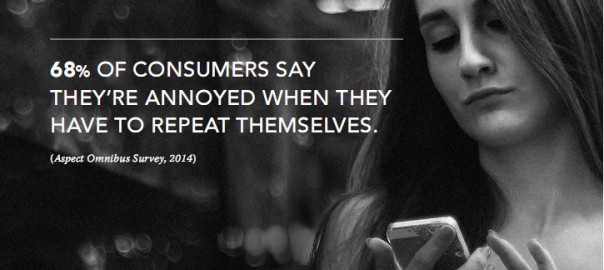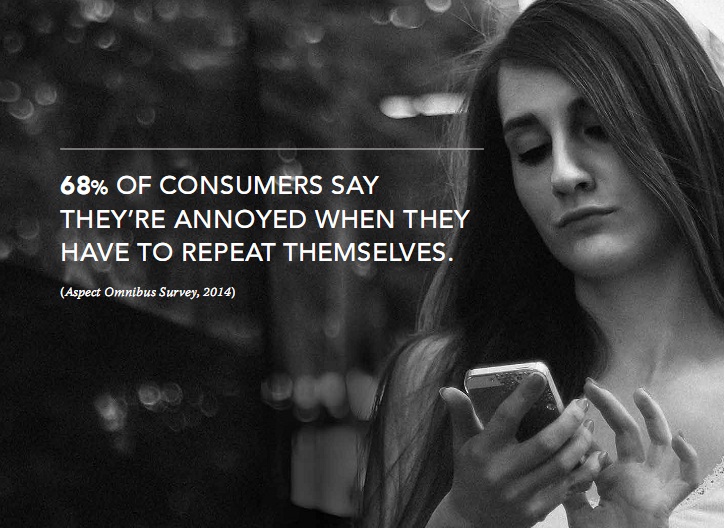
BY 2017, AN ESTIMATED 35% OF CUSTOMER SUPPORT INTERACTIONS WILL TAKE PLACE ON A MOBILE DEVICE.

The new reality of the mobile world.
Customers are talking, texting, tweeting, browsing and chatting more than ever. Their lifestyles demand fast, convenient access to information. Customers are also more self-reliant, often using self-service channels, peer-based communities and social networks to get help. Not surprisingly, people have little tolerance for poor service. They’ll simply take their business elsewhere. Failure to address these changing consumer needs can put your business at risk.
#1 Know Me
TO DELIVER GREAT SERVICE AND BUILD STRONG RELATIONSHIPS, you need to understand consumer preferences and be able to personalize your interactions. As your company offers more contact points, it’s imperative you maintain the context of every conversation – even when customers move between self-service and agent-assisted channels. Small traces of information about the customer’s journey, like the dropout point in an IVR or a failed web site transaction, can make subsequent interactions much more satisfying. With this information, you can dynamically adapt a self-service menu or provide an agent with background information to pick up the conversation where the customer left off. This kind of data can also help you deliver proactive service that gives customers what they need before they have to ask.
#2 Make it Mobile
CONSUMERS TODAY EXPECT TO INTERACT WITH YOUR BUSINESS ACROSS ALL MOBILE-AVAILABLE CHANNELS, including voice, SMS, chat, social, web sites and of course mobile apps. Unfortunately, most mobile channels offer a fragmented customer experience because they’re disconnected from the contact center. It’s critical to think about customer service when building mobile apps, so that you can create a seamless transition when customers need to call into an IVR or connect with an agent.
#3 Let Me Do It Myself
YOUR CUSTOMERS ARE MORE SELFRELIANT THAN EVER. In fact, most people contact companies only after they’ve been unable to solve an issue on their own. Before they reach out for help, they’ve likely searched the internet, looked at product forums and received feedback through social media. To better serve your customers, offer an omni-channel self-service solution. Investing in rich, personalized and integrated self-service is a win-win. It brings you in line with consumer preferences while lowering costs and elevating your agents to experts who can focus on more complex interactions.
#4 Make It Social
SOCIAL MEDIA IS A VITAL CHANNEL FOR COMPANIES TO COMMUNICATE WITH THEIR CUSTOMERS. However, it is often underutilized. Maritz Research found that approximately 70% of customer service complaints made on Twitter go unanswered. Companies that fail to respond to customers risk negative posts, tarnished reputations and lost revenue. They also miss out on opportunities to create brand advocates and build loyalty. Implementing a solution with powerful social workflow capabilities tuned to the needs of the contact center ensures that your customers will receive consistent, informed responses through social networks.
66% OF CUSTOMERS SAY THAT VALUING THEIR TIME IS THE MOST IMPORTANT THING A COMPANY CAN DO TO PROVIDE GOOD SERVICE.
(Forrester) 45% OF U.S. ADULTS WILL ABAN-DON THEIR ONLINE PURCHASE IF THEY CAN’T FIND A QUICK ANSWER TO THEIR QUESTION. (Forrester)
#5 Save Me Time
CONSUMERS WANT FAST, EASY ACCESS TO INFORMATION. Research shows a strong correlation between effort and loyalty – the easier you are to do business with, the more likely consumers will stick around. To stay competitive, companies must find ways to provide intelligent, personalized service that saves people time. Lowering customer effort can be as simple as being where they are. For example, an instant chat button embedded on a web site or in a mobile app to help consumers get quick answers at the point of purchase. Another way to save consumers time is by streamlining self-service menus based on frequent behaviors or a recent transaction. When consumers need live assistance, they appreciate knowledgeable agents who have the resources and tools needed to quickly resolve their issues – without asking them to repeat information.
92% OF CONSUMERS TRUST RECOMMENDATIONS FROM FRIENDS AND FAMILY OVER ALL FORMS OF DVERTISING. (Nielsen) 79% OF CONSUMERS TRUST ONLINE REVIEWS AS MUCH AS PERSONAL RECOMMENDATIONS. (BrightLocal Survey)
#6 Make Me Smarter
EDUCATING YOUR CUSTOMERS IS ONE OF THE BEST WAYS TO INCREASE SALES, create long-term loyalty and inspire recommendations on social networks or peer communities.
According to the White House Office of Consumer Affairs, loyal customers are worth up to 10 times as much as their first purchase.That’s why, it’s worth the effort to help your customers discover new and improved ways to use your products or services. When you empower people with information, they can become an extension of your support team – providing answers for other customers who ask questions through social media and peer communities. Well-informed customers are also more likely to become loyal brand advocates and recommend you to friends and family.
Source: Aspect
